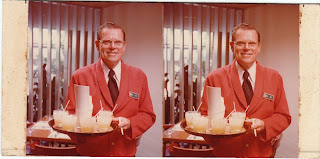



Anyone can make a stereoscope photograph, but sometimes the question has to be why. Stereoscopic imaging tricks one's brain into creating depth perception. Ever since the technique was discovered in 1838 by Sir Charles Wheatstone, it has been a slippery slope all the way to Imax and beyond. My favorites are the striking hyper-color stereo slides of hoochie-kootchie girls from the 1950's. (Followed closely by Andy Warhol's Frankenstein in 3-D. While watching I remember reaching out over the head of the person sitting in front of me to catch a piece of dripping liver as it was being thrust towards the audience). The National Stereoscopic Association has an annual convention, and I have actually been to one, but to paraphrase a vintage t-shirt slogan "I went to the stereoscope show but all I got was this creepy relative, four screwdrivers, a leering bartender and a greek waiter"
Set of Four Anonymous Sterescopic image cards, c. 1965 Collection Jim Linderman

















































